
VMAC – Vehicle Mounted Air Compressors
Toll Free: 1-800-738-8622
Local 1-250-740-3200
Fax: 1-250-740-3201
1
Service Procedures for VMAC Underhood Air
Compressor Systems
200 Hour Service Kits A700219 (VR LITE)
400 Hour Service Kits A700220 (VR LITE)
General Service Information
Safety and Service Precautions
Observe these precautions when performing any service:
• Never attempt to clean the air filter element with compressed air. Replace the air filter element.
• Do not over-tighten the air filter cover retaining nut as this may crush and damage the filter.
• To prevent damage to the oil filter, always use a proper filter wrench. Never over-tighten the filter, as this may damage the seal
or the filter.
• Never use any lubricant other than the supplied compressor oil, as other lubricants will damage the compressor and will void
warranty.
• Do not overfill the system, as this can flood the sight glass window and make the system appear empty.
• If the system has been operating, shut it off and wait at least 30 seconds for the air pressure to vent before performing service.
You must make sure that there is no pressure left in the system. If there is a pressure gauge, make sure that
it is at zero before commencing service. If you are not sure, attach a tool or air nozzle to the air outlet and
make sure that there is no pressure.
• If the system is cold, bring the engine to operating temperature and then operate the compressor system for a few minutes to
bring the compressor oil to operating temperature. This will also help to suspend contaminants in the oil so that they can be
removed from the system along with the old oil.
• Ensure system is fully depressurized prior to beginning service work.
• Observe all safety procedures relating to moving belts, hot oil and compressed air. Use all safety equipment to protect yourself.
• Check the old oil for any evidence of metal filings or contamination; if found, flush the tank (using VMAC flushing kit A700223),
hoses and cooler. Metal filings will damage the compressor.
!
OIL FILL
MUFFLER
OIL DRAIN
OIL
FILTER
PRESSURE
RELIEF VALVE
OIL LEVEL
SIGHT GLASS
COALESCING
FILTER

VMAC – Vehicle Mounted Air Compressors
Toll Free: 1-800-738-8622
Local: 1-250-740-3200
Fax: 1-250-740-3201
2
Flushing Procedure
Component failure (such as compressor, hose or cooler core) can leave metal filings and other foreign materials in the system. To
flush the system, follow this procedure:
1. Before replacing any failed component, check all other system components for evidence of contamination and clean thoroughly.
Use compressed air to blow out lines and other components. Remove the oil filter and drain out oil from the filter. If there is no
metal in the oil filter, continue with the regular flush procedure, (continue to step 2).
If there is metal in the oil filter, look for metal in the return line to the compressor. If metal is found, the cooler must be flushed
before the new compressor is installed. As well, the lines from the tank to the cooler and cooler to compressor need to be
thoroughly checked/flushed or replaced before installing the new compressor.
2. Once the system has been cleaned as thoroughly as possible, replace the failed component and reconnect all lines and fittings.
3. Install a new oil filter and fill the system with VMAC compressor oil to the correct level.
4. Start the engine and engage the air system. Allow the system to pressurize and allow it to operate in no-load mode for about 15
minutes without discharging any air.
5. Shut-down, allow the system to cool and change the oil and the oil filter. Refill with compressor oil to the correct level.
6. After 50 hours, replace the oil filter and top up the oil level.
Service Kit Contents
A 200 hour service kit will contain an air filter, oil filter and sufficient oil for the system, 1.05 USG (4 liters)
A 400 hour service kit will contain the components of the 200 hour service kit plus a coalescing separator filter, pressure relief valve,
and muffler.
200 Hour Service Procedures
1. Inspect the Drive Belt
Check the drive belt carefully for evidence of glazing, missing portions of the ribs or damage to the belt edges and surface. If the belt is
damaged, install a new drive belt.
Inspect all pulleys and idlers for damage. If any component shows cracks, chipping, impact damage or any other indications of
physical damage, replace the pulley or idler.
If the damage indicates possible misalignment, check pulley alignment. If the pulleys are not properly aligned, check all fasteners to
ensure that they are properly tightened and that there are no loose components.
2. Inspect the Pressure Relief Valve
Check the pressure relief valve for evidence of corrosion or loss of functionality. Test the pressure relief valve by pressurizing the
system, pull the ring on the pressure relief valve to fully depressurize the system, then release the ring and ensure the system fully
pressurizes again. If the pressure relief valve is showing signs of losing functionality, contact your local authorized VMAC dealer for
a replacement part.
3. Inspect the Muffler
Visually inspect the muffler for evidence of corrosion or blockages. Ensure that the muffler allows the blowdown cap to function.
Pressurize the system, turn off, and listen for the pressurized air to blowdown through the muffler. If the muffler is showing signs of
blockage, contact your local authorized VMAC dealer for a replacement part.

VMAC – Vehicle Mounted Air Compressors
Toll Free: 1-800-738-8622
Local 1-250-740-3200
Fax: 1-250-740-3201
3
4. Replace the Air Filter
1. Clean loose debris from the area around the compressor and the filter cover to prevent contamination entering the compressor.
2. Remove the filter cover retaining nut, the filter cover and the filter element.
3. Immediately cover the air inlet opening by masking with tape or with a clean cloth to prevent contamination. Do not use
compressed air or perform any other tasks around the compressor until the filter and cover are replaced.
4. Clean the inside of the filter cover with a clean, dry cloth. Do not use flammable solvents to clean the inside of the cover. If you
do use solvent, rinse the inside of the cover thoroughly with fresh water and dry it before installing the cover.
5. Remove the cloth or masking and install a new air filter element. Make sure that the filter fits over the machined step on the
housing.
6. Replace the cover and secure it with the cover bolt. Do not over-tighten the bolt.
5. Replace the Oil Filter
Hot oil can cause severe burns.
1. Clean the area around the tank and the filter to prevent contamination.
2. Remove the drain plug and drain the oil into a container large enough to hold at least 1.05 USG (4 liters).
3. Install and tighten the plug.
4. Remove the oil filter by turning it counterclockwise. Before discarding the filter, check to make sure that the threaded nipple did
not unscrew with the filter. If the nipple is in the filter, remove it carefully to avoid thread damage and replace it in the tank
housing.
5. Check the gasket-sealing surface on the front of the tank for contamination, old gasket material or damage.
6. Apply a thin coating of compressor oil to the filter-sealing gasket and fill the filter with VMAC compressor oil.
7. Spin the filter onto the threaded nipple until the gasket contacts the sealing surface on the tank, then tighten the filter an
additional 3/4 to 1 turn to seat the sealing gasket.
6. Replace the Oil
1. Remove fill cap from the the oil fill port on the oil separator tank.
2. Using a funnel, add approximately 3 liters of VMAC compressor oil, then check the oil level in the sight glass at the front of the
separator tank. If required, add further oil in small quantities until the oil level is between the “ADD” and “MAX” arrows in the
sight glass.
3. Install the fill cap and tighten securely.
!
FILTER
HOUSING
RETAINING
NUT/WASHER
FILTER ELEMENT
FILTER
COVER

VMAC – Vehicle Mounted Air Compressors
Toll Free: 1-800-738-8622
Local: 1-250-740-3200
Fax: 1-250-740-3201
4
7. Completing the Service
1. Place the manual transmission in neutral or the automatic transmission in park and fully apply the park brake.
2. Start the engine and allow it to reach operating temperature.
3. Turn the compressor switch on the control unit to the “ON” position, allow the system to pressurize and return to preset base
idle speed.
4. Turn the compressor switch on the control unit to the “OFF” position.
5. Allow the system to settle for 5 minutes, and then check the oil level through the sight glass. The level must be between the
minimum and maximum level indicators.
6. Check for oil leaks.
400 Hour Service Procedures
1. General Service
Follow procedures numbered 1, 2 and 3 in the 200 hour service instructions for inspecting the belt, replacing the air filter, draining
the oil and replacing the oil filter.
You must make sure that there is no pressure left in the system. If there is a pressure gauge, make sure that
it is at zero before commencing service. If you are not sure, attach a tool or air nozzle to the air outlet and
make sure that there is no pressure.
2. Changing the Coalescing Separator Filter
1. Clean the area around the tank and the filter to prevent contamination.
2. Remove the oil filter by turning it counterclockwise.
3. Check sealing surface on the top of the tank for contamination, old gasket material or damage.
4. Apply a thin coating of compressor oil to the filter-sealing gasket.
5. Spin the filter onto the threaded nipple until the gasket contacts the sealing surface on the tank, then tighten the filter an
additional 3/4 to 1 turn to seat the sealing gasket.
6. Operate the system and check for leaks.
3. Repeat steps 5 and 6 from the 200 hour service replace (oil filter and replace oil)
4. Replace the Muffler
1. Clean the area around the muffler.
2. Remove the old muffler.
3. Apply Loctite 242 around the threads of the new muffler as required.
4. Install the new muffler and tighten securely. Do not over torque.
COALESCING
FILTER
!

VMAC – Vehicle Mounted Air Compressors
Toll Free: 1-800-738-8622
Local 1-250-740-3200
Fax: 1-250-740-3201
5
5. Replace the Pressure Relief Valve
1. Clean the area around the pressure relief valve.
2. Remove the old pressure relief valve.
3. Install the new pressure relief valve and tighten securely. Do not over torque.
6. Repeat step 7 from the 200 hour service (Completing the Service)
Document #1901010
Version
Revision Details
Revised by/date
Approved by/date
Implemented
A
INITIAL RELEASE
A PARKIN 25 Jun 2015
MH/DB 09 Jul 2015
09 Jul 2015
Copyright 2009 All trademarks used in this manual are the property of the respective copyright holder. The contents of this manual may not be reproduced in any form without the
express written permission of VMAC, 1333 Kipp Road, Nanaimo, BC V9X 1R3. Printed in Canada
-
 1
1
-
 2
2
-
 3
3
-
 4
4
-
 5
5
Vmac A700220 Installation guide
- Type
- Installation guide
- This manual is also suitable for
Ask a question and I''ll find the answer in the document
Finding information in a document is now easier with AI
Related papers
-
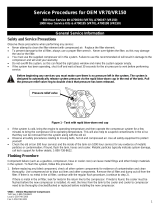 Vmac A700195 Installation guide
Vmac A700195 Installation guide
-
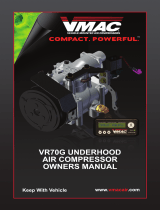 Vmac V90G136 Owner's manual
Vmac V90G136 Owner's manual
-
 Vmac A700211 Installation guide
Vmac A700211 Installation guide
-
 Vmac A700206 Installation guide
Vmac A700206 Installation guide
-
 Vmac V300006 Owner's manual
Vmac V300006 Owner's manual
-
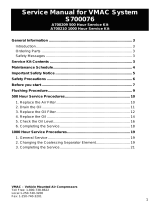 Vmac A700209 Installation guide
Vmac A700209 Installation guide
-
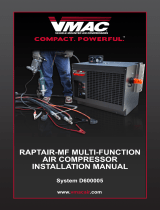 Vmac D600005 Installation guide
Vmac D600005 Installation guide
-
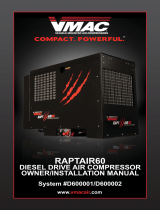 Vmac D600002 Installation guide
Vmac D600002 Installation guide
-
 Vmac A700233 Installation guide
Vmac A700233 Installation guide
-
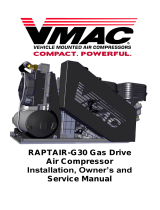 Vmac G300001 Owner's manual
Vmac G300001 Owner's manual














